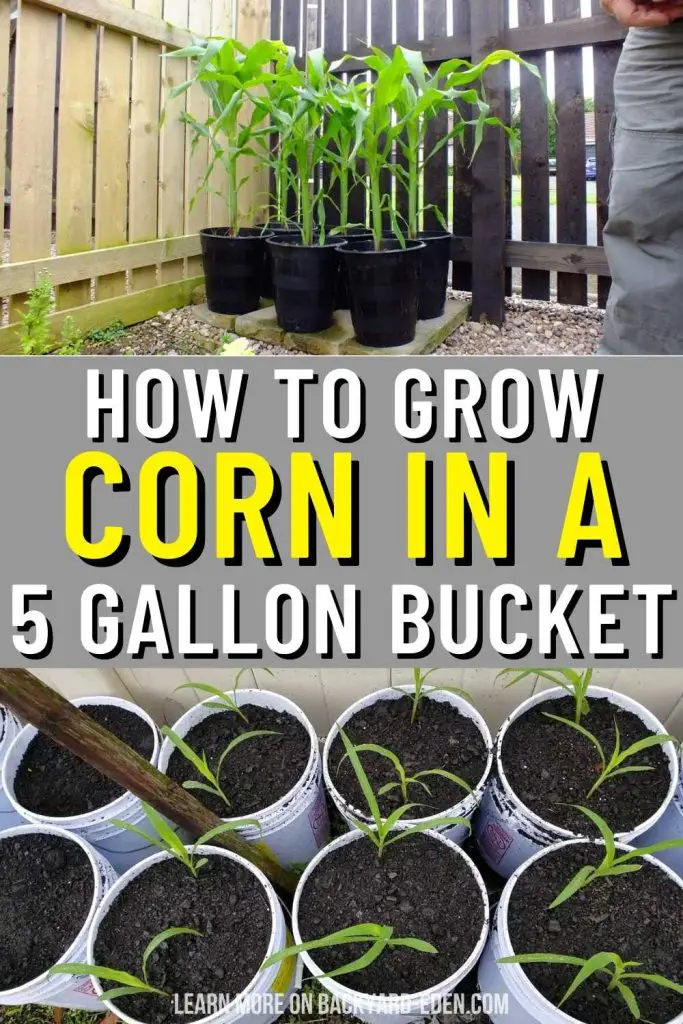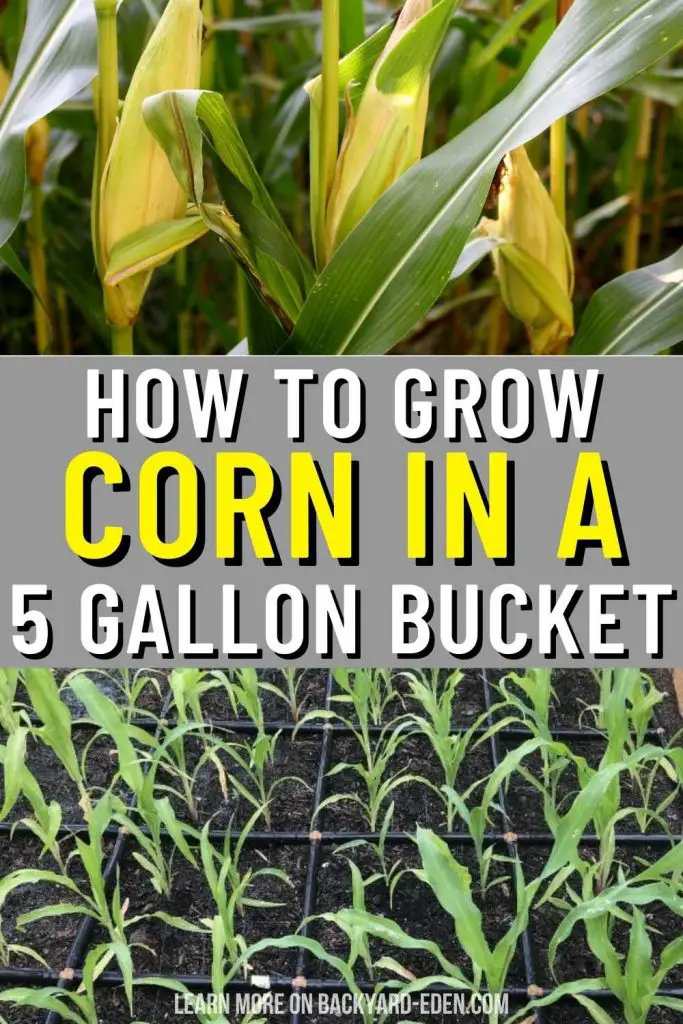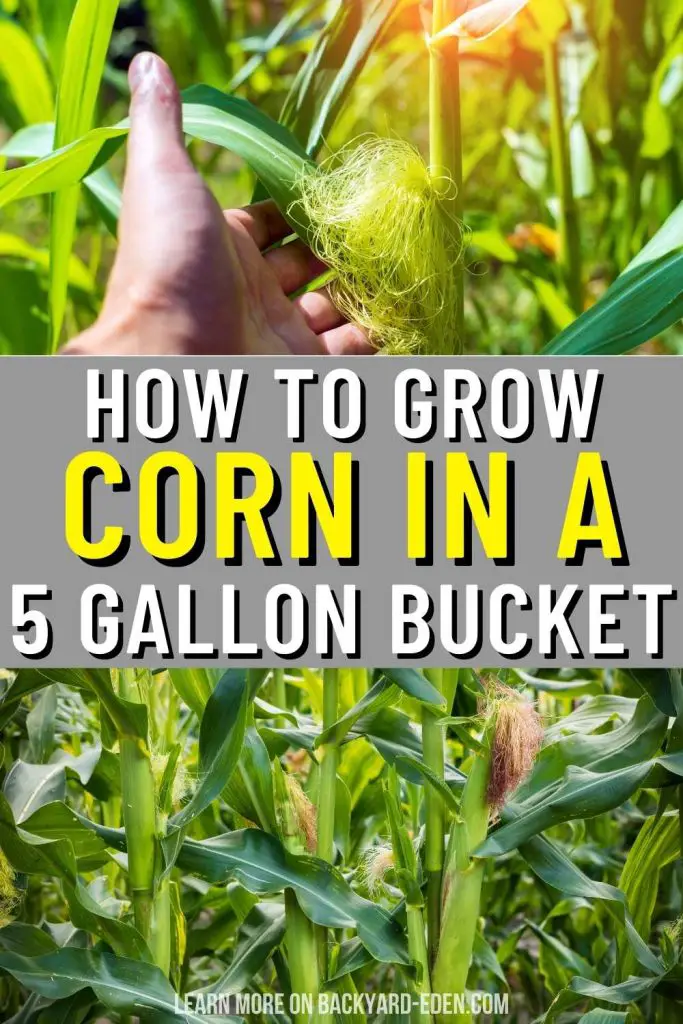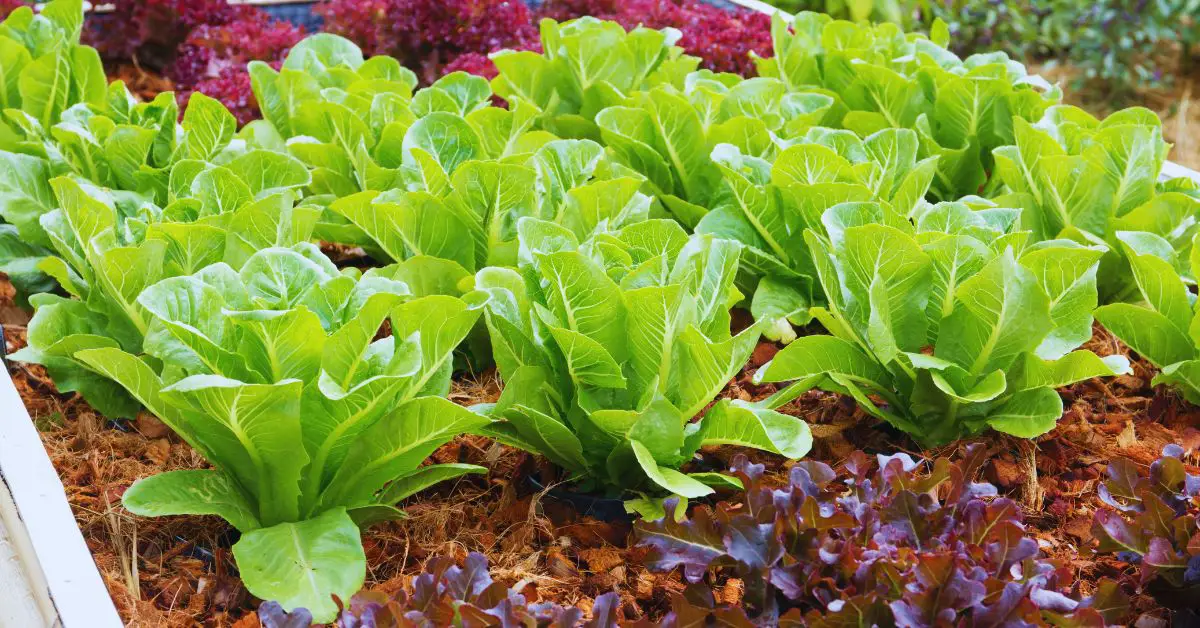If you’ve ever wondered about the possibility of growing corn in a 5-gallon bucket, you’ll be surprised by the simplicity and convenience of this gardening method. Imagine the satisfaction of harvesting your own fresh corn right from your patio or balcony.
With a few key tips and tricks, you can begin on this unique gardening journey and witness the magic of corn sprouting and thriving in a confined space.
Stay tuned to uncover the secrets of successfully nurturing corn in a compact container, and soon you’ll be enjoying the fruits of your labor.
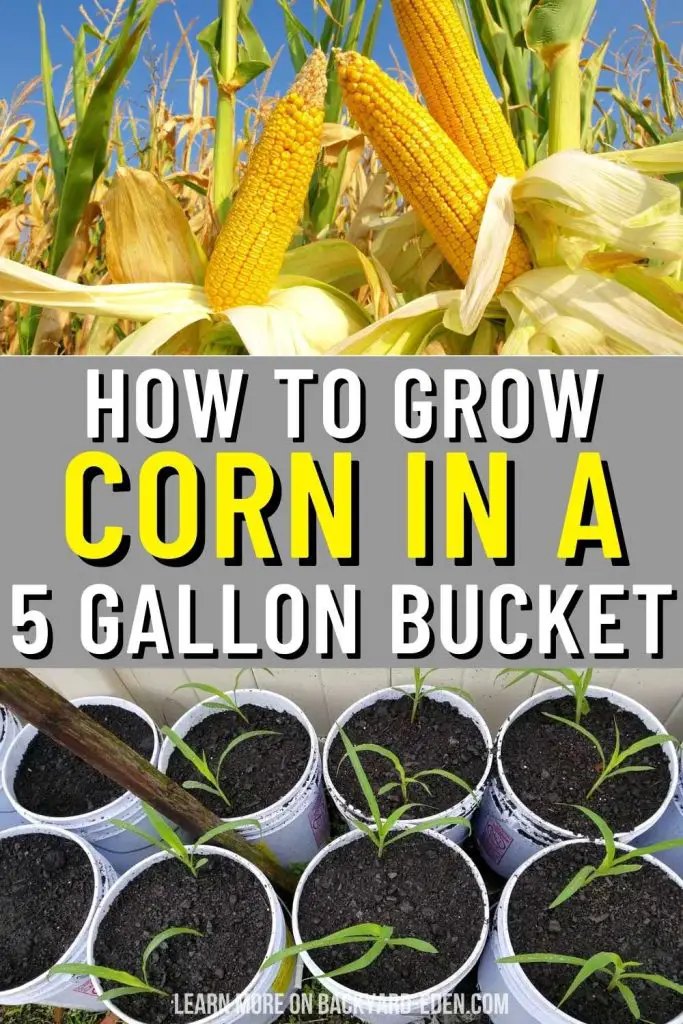
Key Takeaways
- Choose a compact corn variety suitable for containers.
- Drill drainage holes in the bucket for proper aeration.
- Plant seeds at a depth of 1-2 inches in well-draining soil.
- Ensure adequate sunlight exposure for at least 6-8 hours daily.
- Water consistently and monitor soil moisture levels closely.
Selecting the Right Corn Variety
When growing corn in a 5-gallon bucket, select a compact corn variety that’s suitable for container gardening. Choose a variety known for its ability to thrive in limited space and shallow soil conditions.
Begin by preparing well-draining soil by mixing potting mix with compost for nutrients. Dig a small hole in the center of the bucket and plant the corn seeds at a depth of about 1-2 inches. Make sure the seeds are spaced adequately to avoid overcrowding as they grow.
Water your corn plants frequently, making sure the soil stays consistently moist but not waterlogged. Corn typically requires around 1 inch of water per week, so adjust watering frequency based on the weather conditions.
Place the bucket in a location that receives full sunlight for at least 6-8 hours a day. Corn plants are sun-loving and need ample sunlight to thrive and produce healthy ears of corn.
Choosing the Perfect 5-Gallon Bucket
When choosing the perfect 5-gallon bucket for growing corn, consider the material options such as plastic or metal. This choice can impact durability and heat retention. Make sure the bucket size is adequate for corn growth. Check for drainage holes to prevent waterlogging.
Lastly, assess handle design for ease of transportation and mobility within your gardening space.
Bucket Material Options
Consider the various bucket material options available when choosing the perfect 5-gallon bucket for growing corn.
When it comes to bucket material comparison, durability versus cost is a key factor to weigh. Plastic buckets are a popular choice due to their affordability and lightweight nature, making them easy to move around.
However, plastic may not be as durable as metal buckets, which can withstand more wear and tear over time. Metal buckets are sturdier but tend to be heavier and more expensive.
Additionally, consider the environmental impact of bucket materials. Plastic buckets, while cost-effective, aren’t as eco-friendly as metal buckets, which can be recycled indefinitely.
When selecting the ideal bucket material, take into account both the longevity of the material and its impact on the environment, ensuring that your choice aligns with your values and gardening needs.
Size and Drainage Holes
Selecting the appropriate size and ensuring proper drainage holes in your 5-gallon bucket are important steps for successful corn cultivation. When it comes to bucket size, aeration is essential for the roots to receive enough oxygen. Opt for a 5-gallon bucket to provide ample space for the corn to grow comfortably.
The ideal bucket dimensions are around 12 inches in diameter and 14-16 inches in height. This size allows for proper root development and stability for the corn plant.
Drainage holes play a significant role in maintaining the right moisture levels for your corn. To guarantee adequate drainage, drill 4-6 holes in the bottom of the bucket using a 1/4 inch drill bit. These holes will prevent waterlogging, which can lead to root rot and other issues.
Proper spacing between the drainage holes is important to avoid water pooling in one area. Space the holes evenly around the bottom of the bucket to promote uniform drainage and aeration throughout the soil.
Handle Considerations
For smooth transportation and handling during your corn cultivation project, it’s important to evaluate the design and durability of the bucket handles when selecting the ideal 5-gallon bucket. When considering bucket handles, opt for sturdy, ergonomic designs that allow for a comfortable grip. Make sure that the handles are securely attached to the bucket to prevent any accidents during relocation or maintenance tasks.
Bucket placement plays a pivotal role in the growth of your corn. The handles should be situated in a manner that facilitates easy movement without causing strain. Additionally, the placement of the handles shouldn’t obstruct sunlight exposure to the corn plants. Proper sunlight exposure is essential for the photosynthesis process, aiding in the healthy development of your corn crop.
Choose a 5-gallon bucket with handles that aren’t only functional but also complement your gardening routine. By carefully evaluating the handle design and placement, you can ensure a seamless corn cultivation experience and foster a sense of belonging in your gardening endeavors.
Preparing the Bucket for Planting
First, choose a 5-gallon bucket that’s at least 12 inches deep to accommodate the corn’s root system.
Next, drill drainage holes in the bottom of the bucket to prevent waterlogging.
Then, fill the bucket with well-draining soil mixed with compost for nutrients.
Bucket Size and Depth
Consider using a 5-gallon bucket with a depth of at least 12 inches when preparing it for planting corn. The width of the bucket should be sufficient to accommodate the growth of multiple corn plants. A deeper bucket allows for better root development, which is essential for the corn plants to thrive.
The depth of the bucket plays an important role in providing ample space for the roots to establish a strong foundation and absorb nutrients effectively.
When selecting a bucket, make sure it has a diameter of around 12-14 inches to give the corn plants ample room to grow and spread out. The depth is particularly significant as corn plants develop a deep root system to support their height and yield.
A deeper bucket also helps prevent the plants from tipping over as they grow taller. By choosing a bucket with the right size and depth, you set the stage for successful corn cultivation in a confined space.
Drainage Holes and Soil
To ensure proper drainage, drill holes in the bottom of the bucket and then proceed to add a suitable potting mix for planting your corn crop. The drainage holes are vital to prevent waterlogging, which can lead to root rot and stunted growth.
When choosing a potting mix, opt for a well-draining blend that’s rich in nutrients to support the corn plants’ growth. A mix containing perlite or vermiculite can help improve drainage efficiency. Ensure that the soil composition is loose and well-aerated to promote healthy root development.
Corn plants require full sunlight exposure, so place your bucket in a location that receives at least 6-8 hours of direct sunlight daily. Adequate sunlight is essential for photosynthesis, which is necessary for the plants to produce energy and grow.
When watering, aim to keep the soil consistently moist but not waterlogged. Avoid overwatering, as this can lead to fungal diseases. A good watering technique is to water deeply but infrequently, allowing the soil to dry out slightly between waterings.
Selecting the Ideal Potting Mix
When selecting the ideal potting mix for growing corn in a 5-gallon bucket, make sure it’s a well-draining, nutrient-rich blend to support healthy plant growth. To guarantee proper growth, choose a potting mix that offers good drainage to prevent waterlogging, which can lead to root rot.
A mix that contains perlite or vermiculite can help with drainage while retaining essential moisture for the corn plants. Additionally, the potting mix should be rich in nutrients, as corn has high nutrient requirements for best growth. Look for a mix that includes organic matter like compost or well-aged manure to provide the necessary nutrients for your corn plants.
To maintain the ideal temperature for corn growth and prevent pests, select a potting mix that’s well-aerated and free from pathogens or pests. Avoid using soil from your garden, as it may contain harmful organisms that can affect your corn plants. By choosing a high-quality potting mix, you can create a healthy environment for your corn to thrive and produce a bountiful harvest.
Planting Corn Seeds
To successfully plant corn seeds in a 5-gallon bucket, make sure the container is filled with the prepared potting mix up to a few inches below the rim. Corn spacing is important; plant each seed about 9-12 inches apart in the bucket to allow sufficient room for growth. After placing the seeds in the soil, gently cover them with a thin layer of potting mix, ensuring they’re well-covered but not buried too deeply.
Maintain a consistent watering schedule to keep the soil moist but not waterlogged. Corn plants require regular watering, especially during hot and dry periods. Check the moisture level of the soil by inserting your finger about an inch into the potting mix – if it feels dry, it’s time to water.
Remember that overwatering can lead to root rot, so it’s crucial to strike a balance. Keep an eye on the moisture levels and adjust your watering routine accordingly to support healthy corn growth in your 5-gallon bucket.
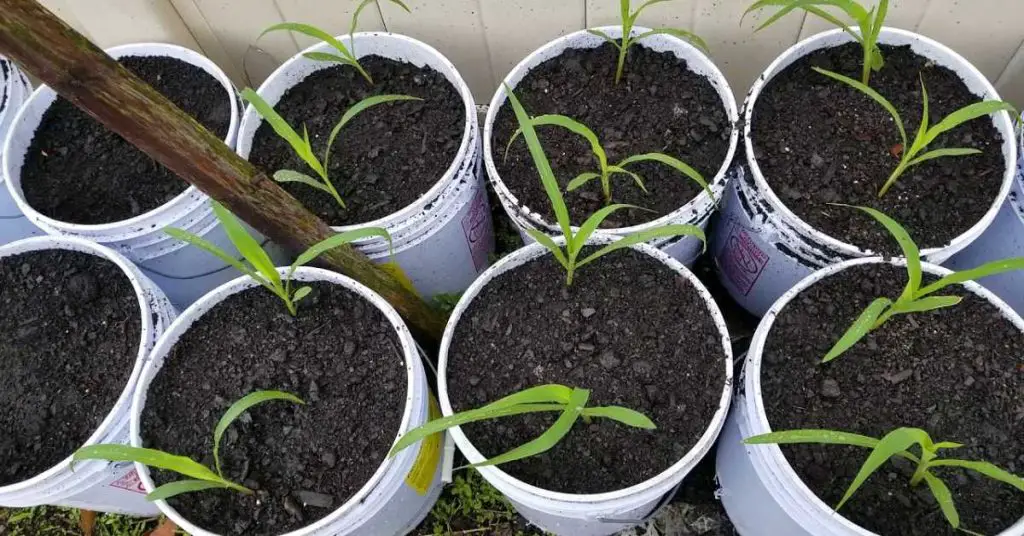
Providing Adequate Sunlight
For best growth and development, make sure your corn plants in the 5-gallon bucket receive ample sunlight throughout the day. Corn plants require full sun, which means they need at least 6-8 hours of direct sunlight daily. Position your bucket in a location that receives the most sunlight, preferably a spot with southern exposure to guarantee the plants get the sunlight they need.
If you’re growing corn from seed indoors to move out when weather permits, consider using indoor lighting options to supplement natural light. LED grow lights are effective for providing the necessary light spectrum for plant growth. Place the lights above the corn plants at a distance of about 12-18 inches from the tops of the plants. Keep the lights on for 12-16 hours a day to mimic the natural daylight cycle.
Once the weather allows, start to move them outdoors a little at a time to get them adjusted.
Watering Corn Plants Properly
To guarantee the best growth of your corn plants, it’s essential to water them consistently but not excessively. Corn plants require evenly moist soil, so be attentive to their moisture needs.
Overwatering can lead to root rot and other issues, so monitor the soil moisture levels closely.
Proper Watering Frequency
Properly watering your corn plants in a 5-gallon bucket requires a consistent and strategic approach to maintain their health and growth. Corn plants have specific hydration needs important for their development. When watering your corn in a bucket, make sure you apply the right watering techniques to support ideal corn growth.
Water your corn plants consistently, aiming for moist but not waterlogged soil. To determine when to water, insert your finger into the soil up to the first knuckle; if it feels dry, it’s time to water. Corn plants require regular watering, especially during hot and dry periods to prevent stress and ensure healthy growth.
Avoid overwatering as it can lead to root rot and other issues. Conversely, underwatering can stunt corn plant growth and reduce yield. Finding the right balance is essential for successful corn cultivation in a bucket. Remember to monitor the soil moisture regularly and adjust your watering frequency accordingly to promote vigorous corn plant development.
Soil Moisture Requirements
Maintain ideal soil moisture levels to support healthy growth of your corn plants in a 5-gallon bucket. Watering techniques play an important role in ensuring your corn plants thrive. Corn plants need consistent moisture to develop properly. Check the soil moisture levels regularly by inserting your finger about an inch into the soil. The soil should feel moist but not waterlogged.
When watering your corn plants, aim to keep the soil consistently moist. Water the plants deeply, ensuring the water reaches the roots. Watering early in the day allows excess moisture to evaporate during the day, reducing the risk of fungal diseases. Adjust the watering frequency based on environmental conditions; hot and windy days may require more frequent watering.
To maintain ideal moisture levels, consider using a mulch layer on top of the soil. Mulch helps retain moisture, reduces evaporation, and keeps the roots cool.
Avoiding Overwatering Issues
Check the soil moisture levels regularly to prevent overwatering issues when growing corn in a 5-gallon bucket. Important watering techniques are essential to avoid root rot and other water-related problems. Corn plants require consistent moisture, but overwatering can be harmful. To maintain the right balance, feel the soil about an inch deep; if it feels dry, it’s time to water.
When watering, aim to moisten the soil evenly without saturating it. Make sure your bucket has adequate drainage holes to prevent water from pooling at the bottom. Excess water can lead to oxygen deprivation in the roots, causing root rot and stunted growth.
To keep the soil moisture at a good level, water your corn plants in the morning to allow excess moisture to evaporate during the day. Adjust the watering frequency based on the weather conditions; during hot and dry periods, you may need to water more frequently.
Fertilizing for Optimal Growth
To ensure your corn plants receive the necessary nutrients for best growth, consider incorporating a balanced fertilizer into their care routine. Organic fertilizers are a great choice for growing corn in a 5-gallon bucket. They provide a slow release of essential nutrients over time, ensuring your plants have a steady supply for peak growth.
Look for organic fertilizers specifically formulated for vegetables or corn to meet their unique nutritional needs.
When selecting a fertilizer, opt for one that has a balanced NPK ratio, such as 10-10-10 or 15-15-15, to promote overall plant health and development. These ratios provide a mix of nitrogen (N) for leafy growth, phosphorus (P) for root development, and potassium (K) for overall plant vigor.
Additionally, consider using organic slow-release fertilizers that break down gradually, providing a consistent nutrient supply to your corn plants without the risk of nutrient burn.
Mulching to Retain Moisture
Consider applying a layer of mulch to your corn plants to effectively retain moisture in the soil. Mulching offers several benefits for your corn crop. To begin with, it helps regulate soil temperature, keeping it cooler during hot days and warmer during cooler nights. This stability promotes healthier root growth and overall plant development.
Additionally, mulch acts as a barrier, preventing excessive evaporation of water from the soil, which is vital for maintaining adequate moisture levels for your corn plants.
To apply mulch, start by ensuring your corn plants are well-watered. Then, spread a layer of organic mulch, such as straw, leaves, or grass clippings, around the base of the plants. Make sure the mulch layer is around 2-3 inches thick but avoid piling it directly against the stalks to prevent rotting.
Replenish the mulch as needed, especially after heavy rainfall or watering, to maintain its moisture retention benefits.
Managing Pests and Diseases
Implementing an integrated pest management strategy is vital for safeguarding your corn crop against common pests and diseases. When growing corn in a 5-gallon bucket, it’s important to monitor your plants regularly for any signs of pest infestations or diseases.
One effective approach is to use natural remedies such as neem oil or insecticidal soap to control pests like aphids, earworms, or corn borers. These natural remedies are environmentally friendly and safe for your plants.
Integrated pest management involves combining different strategies to minimize the use of chemical pesticides while effectively managing pests. You can also introduce beneficial insects like ladybugs or lacewings to your corn crop, as they help control harmful pests naturally.
Additionally, practicing good sanitation by removing any diseased plant material promptly can prevent the spread of diseases like corn smut or leaf blight.
Recognizing Signs of Growth
Identify new leaf growth by observing the emergence of bright green shoots from the center of the corn plant. As your corn begins to grow, it will progress through various stages of development.
Initially, you’ll notice the appearance of two to three long, slender leaves known as the seed leaves or cotyledons. These leaves are followed by the emergence of the first true leaf, which is narrower and longer than the seed leaves. Subsequently, additional leaves will develop, becoming larger and more numerous as the plant continues to grow.
To troubleshoot common issues during the growth stages, keep an eye out for any signs of yellowing or browning on the leaves, which could indicate nutrient deficiencies or overwatering. Make sure that your corn plant receives adequate sunlight and that the soil is well-draining to prevent waterlogged conditions that may stunt growth.
Regularly inspect your plant for pests such as aphids or spider mites, which can hinder growth if left unchecked. By closely monitoring your corn plant’s growth and addressing any issues promptly, you can help guarantee a successful harvest.
Pollinating Corn Indoors
To successfully pollinate your indoor corn plants, you can manually transfer pollen from the tassel to the silks using a gentle shaking motion. Indoor pollination techniques are vital for guaranteeing a successful corn harvest.
When your corn plants begin to produce tassels (the male flowers) and silks (the female flowers), it’s time to intervene and assist with the pollination process. To do this, carefully shake the tassel over the silk strands, allowing the pollen to fall and land on the silks. This action helps the pollen grains to reach the corn silk, facilitating fertilization.
Corn silk management is essential during indoor pollination. Make sure that the corn silks are undamaged and healthy before attempting to pollinate. Gently separate the silks to prevent them from tangling and to allow the pollen to reach the corn kernels effectively.
Harvesting and Enjoying Your Corn
When your corn reaches maturity, it’s time to harvest the ears for enjoying the fresh taste of homegrown corn. To harvest, grasp the ear firmly and pull downward with a twisting motion to detach it from the stalk. For best flavor, cook the corn as soon as possible after harvesting.
Boil the ears for 3-5 minutes or until kernels are tender. You can also try grilling or roasting the corn for a smoky flavor.
To make the most of your homegrown corn, experiment with different corn recipes. Enjoy classic dishes like corn on the cob with butter and salt or get creative with corn salads, chowders, and salsas.
For storing harvested corn, refrigerate ears with husks on in a plastic bag for up to 3 days. For longer storage, blanch the corn and freeze it for up to 10-12 months. When consuming refrigerated corn, steam or microwave it briefly to reheat.
Frequently Asked Questions
Can Corn Be Grown in a 5-Gallon Bucket Indoors?
To grow corn indoors in a 5-gallon bucket, you need proper indoor lighting for photosynthesis, consistent watering to meet corn’s needs, adequate air circulation for pollination, and temperature control to mimic outdoor conditions.
How Often Should Corn Plants Be Pruned?
To maintain healthy corn plants, prune them regularly. Pruning frequency depends on the growth stage; generally, trim every 1-2 weeks. Benefits include improved airflow, light exposure, and overall plant health. Use clean, sharp tools for precise cuts.
Can I Use Recycled Soil for Planting Corn?
You can use recycled soil for planting corn by amending it with compost to improve nutrient content. Make sure the soil pH is suitable for corn growth. Testing the pH and adjusting it as needed will help your corn thrive.
Do I Need to Hand-Pollinate Corn Indoors?
When indoors, hand-pollinating corn can guarantee successful pollination and increase yields. Use a small brush or shake the tassels to transfer pollen. Avoid cross-contamination. This method offers precise control and promotes better corn development.
What Is the Best Way to Store Harvested Corn?
When storing harvested corn, the best options are freezing or canning. Freezing maintains the corn’s freshness for several months, while canning offers long-term preservation. Make sure proper packaging to prevent freezer burn or spoilage.
Conclusion
To sum up, growing corn in a 5-gallon bucket is a rewarding and practical way to enjoy fresh corn at home. By following the steps outlined in this guide, from selecting the right variety to harvesting your crop, you can successfully cultivate corn in a confined space.
With proper care and attention to detail, you can enjoy the fruits of your labor and savor the delicious taste of homegrown corn. Happy planting!
